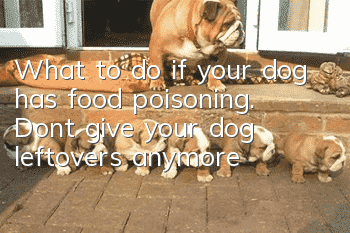What to do if your dog has food poisoning. Don’t give your dog leftovers anymore!

First aid for dog food poisoning
When a dog shows symptoms of poisoning, the owner of the dog does not need to panic and be nervous, but should calmly analyze the cause of the disease. Depending on the poisoned food and the length of time it was eaten, the following emergency measures can be taken:1. Inducing and anti-vomiting:
Use emetic drugs shortly after eating the food. You can take 50 to 100 ml of 1% zinc sulfate solution. If necessary, use apomorphine (apomorphine) 3 mg subcutaneously. When spoiled food has been eaten for more than 4 hours and most of the food has entered the duodenum, emetic drugs cannot be used. Vomiting drugs should be used with caution in pregnant dogs. When vomiting is over, antiemetic drugs, such as diphenhydramine hydrochloride, can be used. The dog can be injected intramuscularly with 0.5~2 mg/kg body weight, and the oral dose is 2~5 mg/kg body weight, twice a day. Diphenamine 1~1.5 mg/kg body weight, intramuscular or subcutaneous injection.
2. Diarrhea and antidiarrhea:
Drhargy is another method to promote the excretion of toxins in the gastrointestinal tract. If you have eaten toxic food for more than 2 to 3 hours and your mental state is still good, you can take laxatives to promote the elimination of toxic food as soon as possible. Be careful not to use vegetable oil when taking purgative measures. When the intestinal contents are basically exhausted, antidiarrheal drugs, such as atropine sulfate, can be used, 0.3 to 1 mg per time for dogs, kilogram of body weight, subcutaneous or intramuscular injection.
3. Antibacterial and anti-inflammatory:
In order to prevent the bacteria in the intestine from continuing to grow and reproduce and produce toxins, broad-spectrum antibiotics, such as gentamicin, chloramphenicol or tetracycline, should be taken orally.
4. Anti-shock:
In order to prevent shock in dogs, corticosteroids can be used, such as intramuscular injection of dexamethasone, 0.25~1 mg each time, or prednisone, prednisolone and other drugs .
If symptoms improve after the above treatments, you should take rest. If the vomiting and diarrhea are serious, fast temporarily. After the vomiting stops, give a liquid or semi-liquid diet, and let the sick dog drink more light salt water to supplement sufficient water. If there is no improvement or the poisoning symptoms are severe, you should be sent to the hospital for treatment in time.
Causes of food poisoning in dogs
Dogs are most likely to suffer from food poisoning after eating spoiled food. Spoiled and rancid food often contains bacteria such as Salmonella, Clostridium botulinum, and Staphylococcus aureus, which can cause infections in dogs.For example, spoiled fish is contaminated by Proteus, which causes protein decomposition and the production of histamine. The incubation period of histamine poisoning does not exceed 2 hours. The dog will suddenly vomit, have diarrhea, have excessive nasal discharge, have difficulty breathing, and have dilated pupils. Ataxia, etc. At this time, the dog may be comatose, with hindquarters paralysis, weak, urinating blood, and black feces.
Generally, the earlier the symptoms appear, the more serious the poisoning is.
Measures to prevent food poisoning in dogs
1. Feed the dog cooked food, and eat it now. Do not leave it out for a long time.2. Discard fermented and spoiled food and never feed it again, because the toxins released by germs in food cannot be destroyed after heating and can still cause food poisoning or even death. Salmonella toxinsIt has heat resistance and is still toxic after 1 hour at 75 degrees, which can cause food poisoning in animals.
Random articles
- What do dogs eat to protect their stomach? It is important to protect their stomach and treat gastrointestinal diseases in dogs.
- How to tell if your dog is fat? Is your dog overweight?
- Will your dog catch a cold if you blow the air conditioner? What should you do if your dog catches a cold if you blow the air conditioner?
- What should you pay attention to when your dog drinks water? Don’t be careless when it comes to your dog’s drinking water.
- The dog's mouth bites and shakes. Why does the dog's mouth occasionally shake and bite?
- How to cut a dog's hair? Do you know how to cut a dog's hair correctly?
- Can dogs eat raw eggs? Why can’t dogs eat egg whites?
- Common Dog Problems in Summer How to Deal with Different Dog Problems
- How to keep dogs away from skin diseases. If you do this, will you see if your dog will still be infected with skin diseases?
- What causes anorexia in dogs? Dogs will become anorexic due to lack of exercise. Hounds run at least 5KM every day.



